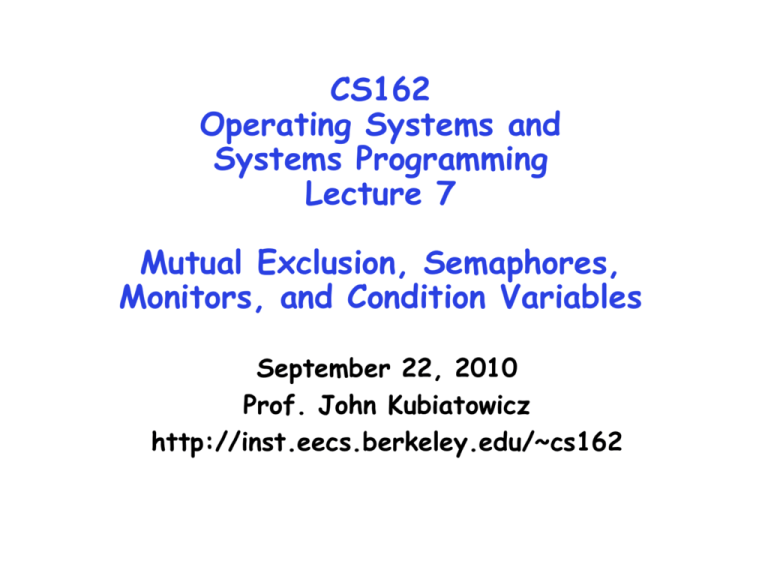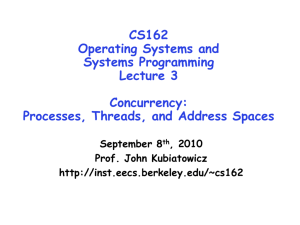Lecture 7: Mutual Exclusion
advertisement

CS162
Operating Systems and
Systems Programming
Lecture 7
Mutual Exclusion, Semaphores,
Monitors, and Condition Variables
September 22, 2010
Prof. John Kubiatowicz
http://inst.eecs.berkeley.edu/~cs162
Review: Synchronization problem with Threads
• One thread per transaction, each running:
Deposit(acctId, amount) {
acct = GetAccount(actId); /* May use disk I/O */
acct->balance += amount;
StoreAccount(acct);
/* Involves disk I/O */
}
• Unfortunately, shared state can get corrupted:
Thread 1
load r1, acct->balance
Thread 2
load r1, acct->balance
add r1, amount2
store r1, acct->balance
add r1, amount1
store r1, acct->balance
• Atomic Operation: an operation that always runs to
completion or not at all
– It is indivisible: it cannot be stopped in the middle and state
cannot be modified by someone else in the middle
9/22/10
Kubiatowicz CS162 ©UCB Fall 2010
Lec 7.2
Review: Too Much Milk Solution #3
• Here is a possible two-note solution:
Thread A
leave note A;
while (note B) {\\X
do nothing;
}
if (noMilk) {
buy milk;
}
remove note A;
Thread B
leave note B;
if (noNote A) {\\Y
if (noMilk) {
buy milk;
}
}
remove note B;
• Does this work? Yes. Both can guarantee that:
– It is safe to buy, or
– Other will buy, ok to quit
• At X:
– if no note B, safe for A to buy,
– otherwise wait to find out what will happen
• At Y:
– if no note A, safe for B to buy
– Otherwise, A is either buying or waiting for B to quit
9/22/10
Kubiatowicz CS162 ©UCB Fall 2010
Lec 7.3
Review: Solution #3 discussion
• Our solution protects a single “Critical-Section” piece
of code for each thread:
if (noMilk) {
buy milk;
}
• Solution #3 works, but it’s really unsatisfactory
– Really complex – even for this simple an example
» Hard to convince yourself that this really works
» Aside for multiprocessors: Only works with Sequentially
Consistent Memory Model
– A’s code is different from B’s – what if lots of threads?
» Code would have to be slightly different for each thread
– While A is waiting, it is consuming CPU time
» This is called “busy-waiting”
• There’s a better way
– Have hardware provide better (higher-level) primitives
than atomic load and store
– Build even higher-level programming abstractions on this
new hardware support
9/22/10
Kubiatowicz CS162 ©UCB Fall 2010
Lec 7.4
Goals for Today
• Hardware Support for Synchronization
• Higher-level Synchronization Abstractions
– Semaphores, monitors, and condition variables
• Programming paradigms for concurrent programs
Note: Some slides and/or pictures in the following are
adapted from slides ©2005 Silberschatz, Galvin, and Gagne.
Gagne
Many slides generated from my lecture notes by Kubiatowicz.
9/22/10
Kubiatowicz CS162 ©UCB Fall 2010
Lec 7.5
High-Level Picture
• The abstraction of threads is good:
– Maintains sequential execution model
– Allows simple parallelism to overlap I/O and computation
• Unfortunately, still too complicated to access state
shared between threads
– Consider “too much milk” example
– Implementing a concurrent program with only loads and
stores would be tricky and error-prone
• Today, we’ll implement higher-level operations on top
of atomic operations provided by hardware
– Develop a “synchronization toolbox”
– Explore some common programming paradigms
9/22/10
Kubiatowicz CS162 ©UCB Fall 2010
Lec 7.6
Too Much Milk: Solution #4
• Suppose we have some sort of implementation of a
lock (more in a moment).
– Lock.Acquire() – wait until lock is free, then grab
– Lock.Release() – Unlock, waking up anyone waiting
– These must be atomic operations – if two threads are
waiting for the lock and both see it’s free, only one
succeeds to grab the lock
• Then, our milk problem is easy:
milklock.Acquire();
if (nomilk)
buy milk;
milklock.Release();
• Once again, section of code between Acquire() and
Release() called a “Critical Section”
• Of course, you can make this even simpler: suppose
you are out of ice cream instead of milk
– Skip the test since you always need more ice cream.
9/22/10
Kubiatowicz CS162 ©UCB Fall 2010
Lec 7.7
How to implement Locks?
• Lock: prevents someone from doing something
– Lock before entering critical section and
before accessing shared data
– Unlock when leaving, after accessing shared data
– Wait if locked
» Important idea: all synchronization involves waiting
» Should sleep if waiting for a long time
• Atomic Load/Store: get solution like Milk #3
– Looked at this last lecture
– Pretty complex and error prone
• Hardware Lock instruction
– Is this a good idea?
– What about putting a task to sleep?
» How do you handle the interface between the hardware and
scheduler?
– Complexity?
» Done in the Intel 432
» Each feature makes hardware more complex and slow
9/22/10
Kubiatowicz CS162 ©UCB Fall 2010
Lec 7.8
Naïve use of Interrupt Enable/Disable
• How can we build multi-instruction atomic operations?
– Recall: dispatcher gets control in two ways.
» Internal: Thread does something to relinquish the CPU
» External: Interrupts cause dispatcher to take CPU
– On a uniprocessor, can avoid context-switching by:
» Avoiding internal events (although virtual memory tricky)
» Preventing external events by disabling interrupts
• Consequently, naïve Implementation of locks:
LockAcquire { disable Ints; }
LockRelease { enable Ints; }
• Problems with this approach:
– Can’t let user do this! Consider following:
LockAcquire();
While(TRUE) {;}
– Real-Time system—no guarantees on timing!
» Critical Sections might be arbitrarily long
– What happens with I/O or other important events?
» “Reactor about to meltdown. Help?”
9/22/10
Kubiatowicz CS162 ©UCB Fall 2010
Lec 7.9
Better Implementation of Locks by Disabling Interrupts
• Key idea: maintain a lock variable and impose mutual
exclusion only during operations on that variable
int value = FREE;
Acquire() {
Release() {
disable interrupts;
disable interrupts;
if (anyone on wait queue) {
if (value == BUSY) {
take thread off wait queue
put thread on wait queue;
Place on ready queue;
Go to sleep();
} else {
// Enable interrupts?
value = FREE;
} else {
}
value = BUSY;
enable interrupts;
}
}
enable interrupts;
}
9/22/10
Kubiatowicz CS162 ©UCB Fall 2010
Lec 7.10
New Lock Implementation: Discussion
• Why do we need to disable interrupts at all?
– Avoid interruption between checking and setting lock value
– Otherwise two threads could think that they both have lock
Acquire() {
disable interrupts;
if (value == BUSY) {
put thread on wait queue;
Go to sleep();
// Enable interrupts?
} else {
value = BUSY;
}
enable interrupts;
}
Critical
Section
• Note: unlike previous solution, the critical section
(inside Acquire()) is very short
– User of lock can take as long as they like in their own
critical section: doesn’t impact global machine behavior
– Critical interrupts taken in time!
9/22/10
Kubiatowicz CS162 ©UCB Fall 2010
Lec 7.11
Interrupt re-enable in going to sleep
• What about re-enabling ints when going to sleep?
Enable Position
Enable Position
Enable Position
Acquire() {
disable interrupts;
if (value == BUSY) {
put thread on wait queue;
Go to sleep();
} else {
value = BUSY;
}
enable interrupts;
}
• Before Putting thread on the wait queue?
– Release can check the queue and not wake up thread
• After putting the thread on the wait queue
– Release puts the thread on the ready queue, but the
thread still thinks it needs to go to sleep
– Misses wakeup and still holds lock (deadlock!)
• Want to put it after sleep(). But – how?
9/22/10
Kubiatowicz CS162 ©UCB Fall 2010
Lec 7.12
Administrivia
• My office hours: MW 2:30-3:30
– Does this work for people?
• First Design Document due Monday 9/25
– Subsequently need to schedule design review with TA
(through web form)
– Note that most of the design document grade comes
from first version (some from final version)
• Design doc contents:
– Architecture, correctness constraints, algorithms,
pseudocode, testing strategy, and test case types
– Should be a document (with headers, actual text, etc)
» Do not include huge blocks of code
» Actually try to make a high-level description of your
design choices, testing methodology, etc
– Must be in .pdf
9/22/10
Kubiatowicz CS162 ©UCB Fall 2010
Lec 7.13
How to Re-enable After Sleep()?
• In Nachos, since ints are disabled when you call sleep:
– Responsibility of the next thread to re-enable ints
– When the sleeping thread wakes up, returns to acquire
and re-enables interrupts
Thread A
Thread B
.
.
disable ints
sleep
sleep return
enable ints
.
.
.
disable int
sleep
sleep return
enable ints
.
.
9/22/10
Kubiatowicz CS162 ©UCB Fall 2010
Lec 7.14
Interrupt disable and enable across context switches
• An important point about structuring code:
– In Nachos code you will see lots of comments about
assumptions made concerning when interrupts disabled
– This is an example of where modifications to and
assumptions about program state can’t be localized
within a small body of code
– In these cases it is possible for your program to
eventually “acquire” bugs as people modify code
• Other cases where this will be a concern?
– What about exceptions that occur after lock is
acquired? Who releases the lock?
mylock.acquire();
a = b / 0;
mylock.release()
9/22/10
Kubiatowicz CS162 ©UCB Fall 2010
Lec 7.15
Atomic Read-Modify-Write instructions
• Problems with previous solution:
– Can’t give lock implementation to users
– Doesn’t work well on multiprocessor
» Disabling interrupts on all processors requires messages
and would be very time consuming
• Alternative: atomic instruction sequences
– These instructions read a value from memory and write
a new value atomically
– Hardware is responsible for implementing this correctly
» on both uniprocessors (not too hard)
» and multiprocessors (requires help from cache coherence
protocol)
– Unlike disabling interrupts, can be used on both
uniprocessors and multiprocessors
9/22/10
Kubiatowicz CS162 ©UCB Fall 2010
Lec 7.16
Examples of Read-Modify-Write
• test&set (&address) {
/* most architectures */
result = M[address];
M[address] = 1;
return result;
}
• swap (&address, register) { /* x86 */
temp = M[address];
M[address] = register;
register = temp;
}
• compare&swap (&address, reg1, reg2) { /* 68000 */
if (reg1 == M[address]) {
M[address] = reg2;
return success;
} else {
return failure;
}
}
• load-linked&store conditional(&address) {
/* R4000, alpha */
loop:
ll r1, M[address];
movi r2, 1;
/* Can do arbitrary comp */
sc r2, M[address];
beqz r2, loop;
}
9/22/10
Kubiatowicz CS162 ©UCB Fall 2010
Lec 7.17
Implementing Locks with test&set
• Another flawed, but simple solution:
int value = 0; // Free
Acquire() {
while (test&set(value)); // while busy
}
Release() {
value = 0;
}
• Simple explanation:
– If lock is free, test&set reads 0 and sets value=1, so
lock is now busy. It returns 0 so while exits.
– If lock is busy, test&set reads 1 and sets value=1 (no
change). It returns 1, so while loop continues
– When we set value = 0, someone else can get lock
• Busy-Waiting: thread consumes cycles while waiting
9/22/10
Kubiatowicz CS162 ©UCB Fall 2010
Lec 7.18
Problem: Busy-Waiting for Lock
• Positives for this solution
– Machine can receive interrupts
– User code can use this lock
– Works on a multiprocessor
• Negatives
– This is very inefficient because the busy-waiting
thread will consume cycles waiting
– Waiting thread may take cycles away from thread
holding lock (no one wins!)
– Priority Inversion: If busy-waiting thread has higher
priority than thread holding lock no progress!
• Priority Inversion problem with original Martian rover
• For semaphores and monitors, waiting thread may
wait for an arbitrary length of time!
– Thus even if busy-waiting was OK for locks, definitely
not ok for other primitives
– Homework/exam solutions should not have busy-waiting!
9/22/10
Kubiatowicz CS162 ©UCB Fall 2010
Lec 7.19
Better Locks using test&set
• Can we build test&set locks without busy-waiting?
– Can’t entirely, but can minimize!
– Idea: only busy-wait to atomically check lock value
int guard = 0;
int value = FREE;
Release() {
Acquire() {
// Short busy-wait time
// Short busy-wait time
while (test&set(guard));
while (test&set(guard));
if anyone on wait queue {
if (value == BUSY) {
take thread off wait queue
put thread on wait queue;
Place on ready queue;
go to sleep() & guard = 0; } else {
} else {
value = FREE;
value = BUSY;
}
guard = 0;
guard = 0;
}
}• Note: sleep has to be sure to reset the guard variable
– Why can’t we do it just before or just after the sleep?
9/22/10
Kubiatowicz CS162 ©UCB Fall 2010
Lec 7.20
Higher-level Primitives than Locks
• Goal of last couple of lectures:
– What is the right abstraction for synchronizing threads
that share memory?
– Want as high a level primitive as possible
• Good primitives and practices important!
– Since execution is not entirely sequential, really hard to
find bugs, since they happen rarely
– UNIX is pretty stable now, but up until about mid-80s
(10 years after started), systems running UNIX would
crash every week or so – concurrency bugs
• Synchronization is a way of coordinating multiple
concurrent activities that are using shared state
– This lecture and the next presents a couple of ways of
structuring the sharing
9/22/10
Kubiatowicz CS162 ©UCB Fall 2010
Lec 7.21
Semaphores
• Semaphores are a kind of generalized lock
– First defined by Dijkstra in late 60s
– Main synchronization primitive used in original UNIX
• Definition: a Semaphore has a non-negative integer
value and supports the following two operations:
– P(): an atomic operation that waits for semaphore to
become positive, then decrements it by 1
» Think of this as the wait() operation
– V(): an atomic operation that increments the semaphore
by 1, waking up a waiting P, if any
» This of this as the signal() operation
– Note that P() stands for “proberen” (to test) and V()
stands for “verhogen” (to increment) in Dutch
9/22/10
Kubiatowicz CS162 ©UCB Fall 2010
Lec 7.22
Semaphores Like Integers Except
• Semaphores are like integers, except
– No negative values
– Only operations allowed are P and V – can’t read or write
value, except to set it initially
– Operations must be atomic
» Two P’s together can’t decrement value below zero
» Similarly, thread going to sleep in P won’t miss wakeup
from V – even if they both happen at same time
• Semaphore from railway analogy
– Here is a semaphore initialized to 2 for resource control:
Value=2
Value=0
Value=1
9/22/10
Kubiatowicz CS162 ©UCB Fall 2010
Lec 7.23
Two Uses of Semaphores
• Mutual Exclusion (initial value = 1)
– Also called “Binary Semaphore”.
– Can be used for mutual exclusion:
semaphore.P();
// Critical section goes here
semaphore.V();
• Scheduling Constraints (initial value = 0)
– Locks are fine for mutual exclusion, but what if you
want a thread to wait for something?
– Example: suppose you had to implement ThreadJoin
which must wait for thread to terminiate:
Initial value of semaphore = 0
ThreadJoin {
semaphore.P();
}
ThreadFinish {
semaphore.V();
}
9/22/10
Kubiatowicz CS162 ©UCB Fall 2010
Lec 7.24
Producer-consumer with a bounded buffer
• Problem Definition
Producer
Buffer
Consumer
– Producer puts things into a shared buffer
– Consumer takes them out
– Need synchronization to coordinate producer/consumer
• Don’t want producer and consumer to have to work in
lockstep, so put a fixed-size buffer between them
– Need to synchronize access to this buffer
– Producer needs to wait if buffer is full
– Consumer needs to wait if buffer is empty
• Example 1: GCC compiler
– cpp | cc1 | cc2 | as | ld
• Example 2: Coke machine
– Producer can put limited number of cokes in machine
– Consumer can’t take cokes out if machine is empty
9/22/10
Kubiatowicz CS162 ©UCB Fall 2010
Lec 7.25
Correctness constraints for solution
• Correctness Constraints:
– Consumer must wait for producer to fill buffers, if none
full (scheduling constraint)
– Producer must wait for consumer to empty buffers, if all
full (scheduling constraint)
– Only one thread can manipulate buffer queue at a time
(mutual exclusion)
• Remember why we need mutual exclusion
– Because computers are stupid
– Imagine if in real life: the delivery person is filling the
machine and somebody comes up and tries to stick their
money into the machine
• General rule of thumb:
Use a separate semaphore for each constraint
– Semaphore fullBuffers; // consumer’s constraint
– Semaphore emptyBuffers;// producer’s constraint
– Semaphore mutex;
// mutual exclusion
9/22/10
Kubiatowicz CS162 ©UCB Fall 2010
Lec 7.26
Full Solution to Bounded Buffer
Semaphore fullBuffer = 0; // Initially, no coke
Semaphore emptyBuffers = numBuffers;
// Initially, num empty slots
Semaphore mutex = 1;
// No one using machine
Producer(item) {
emptyBuffers.P();
mutex.P();
Enqueue(item);
mutex.V();
fullBuffers.V();
}
Consumer() {
fullBuffers.P();
mutex.P();
item = Dequeue();
mutex.V();
emptyBuffers.V();
return item;
}
9/22/10
// Wait until space
// Wait until buffer free
// Tell consumers there is
// more coke
// Check if there’s a coke
// Wait until machine free
// tell producer need more
Kubiatowicz CS162 ©UCB Fall 2010
Lec 7.27
Discussion about Solution
• Why asymmetry?
– Producer does: emptyBuffer.P(), fullBuffer.V()
– Consumer does: fullBuffer.P(), emptyBuffer.V()
• Is order of P’s important?
– Yes! Can cause deadlock
• Is order of V’s important?
– No, except that it might affect scheduling efficiency
• What if we have 2 producers or 2 consumers?
– Do we need to change anything?
9/22/10
Kubiatowicz CS162 ©UCB Fall 2010
Lec 7.28
Motivation for Monitors and Condition Variables
• Semaphores are a huge step up; just think of trying
to do the bounded buffer with only loads and stores
– Problem is that semaphores are dual purpose:
» They are used for both mutex and scheduling constraints
» Example: the fact that flipping of P’s in bounded buffer
gives deadlock is not immediately obvious. How do you
prove correctness to someone?
• Cleaner idea: Use locks for mutual exclusion and
condition variables for scheduling constraints
• Definition: Monitor: a lock and zero or more
condition variables for managing concurrent access to
shared data
– Some languages like Java provide this natively
– Most others use actual locks and condition variables
9/22/10
Kubiatowicz CS162 ©UCB Fall 2010
Lec 7.29
Monitor with Condition Variables
• Lock: the lock provides mutual exclusion to shared data
– Always acquire before accessing shared data structure
– Always release after finishing with shared data
– Lock initially free
• Condition Variable: a queue of threads waiting for
something inside a critical section
– Key idea: make it possible to go to sleep inside critical
section by atomically releasing lock at time we go to sleep
– Contrast to semaphores: Can’t wait inside critical section
9/22/10
Kubiatowicz CS162 ©UCB Fall 2010
Lec 7.30
Simple Monitor Example
• Here is an (infinite) synchronized queue
Lock lock;
Condition dataready;
Queue queue;
AddToQueue(item) {
lock.Acquire();
queue.enqueue(item);
dataready.signal();
lock.Release();
}
//
//
//
//
RemoveFromQueue() {
lock.Acquire();
//
while (queue.isEmpty()) {
dataready.wait(&lock); //
}
item = queue.dequeue(); //
lock.Release();
//
return(item);
}
9/22/10
Get Lock
Add item
Signal any waiters
Release Lock
Get Lock
If nothing, sleep
Get next item
Release Lock
Kubiatowicz CS162 ©UCB Fall 2010
Lec 7.31
Summary
• Important concept: Atomic Operations
– An operation that runs to completion or not at all
– These are the primitives on which to construct various
synchronization primitives
• Talked about hardware atomicity primitives:
– Disabling of Interrupts, test&set, swap, comp&swap,
load-linked/store conditional
• Showed several constructions of Locks
– Must be very careful not to waste/tie up machine
resources
» Shouldn’t disable interrupts for long
» Shouldn’t spin wait for long
– Key idea: Separate lock variable, use hardware
mechanisms to protect modifications of that variable
• Talked about Semaphores, Monitors, and Condition
Variables
– Higher level constructs that are harder to “screw up”
9/22/10
Kubiatowicz CS162 ©UCB Fall 2010
Lec 7.32






